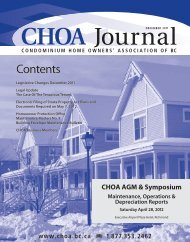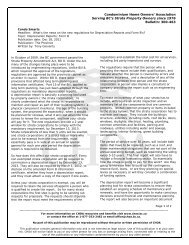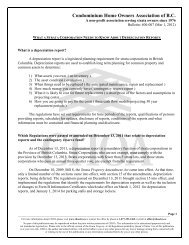Guide to 2-5-10 Warranties
Guide to 2/5/10 Warranty Reporting - CHOA
Guide to 2/5/10 Warranty Reporting - CHOA
Create successful ePaper yourself
Turn your PDF publications into a flip-book with our unique Google optimized e-Paper software.
<strong>Guide</strong> <strong>to</strong> 2-5-<strong>10</strong> <strong>Warranties</strong>LESPERANCE MENDESSuite 4<strong>10</strong>, 900 Howe Street,Vancouver BC Canada V6Z 2M4t 604-685-3567f 604-685-7505www.lmlaw.ca© LESPERANCE MENDES
<strong>Guide</strong> <strong>to</strong> 2-5-<strong>10</strong> <strong>Warranties</strong>The Homeowner Protection Act came in<strong>to</strong> effect on July 1, 1999. The benefits of the “2-5-<strong>10</strong>” home warranty established by this statute are not au<strong>to</strong>matic. Strata corporationsand owners must take steps <strong>to</strong> preserve and enforce their rights. These steps are se<strong>to</strong>ut in their warranty certificates, the Homeowner Protection Act and the HomeownerProtection Act Regulation (the “HPA Regulation”). Failure <strong>to</strong> comply with theserequirements may result in a loss of coverage.2-5-<strong>10</strong> warranties are issued <strong>to</strong> strata corporations, strata lot owners and the owners ofresidential buildings and detached homes. Our <strong>Guide</strong> focuses on 2-5-<strong>10</strong> commonproperty warranties issued <strong>to</strong> strata corporations.This <strong>Guide</strong> sets out steps that may be followed <strong>to</strong> reduce the risk that a 2-5-<strong>10</strong> warranty claim will be denied (it does not address Building EnvelopeRenovation <strong>Warranties</strong>). While these guidelines are necessarily general, thesuccess of each warranty claim will depend on its particular circumstances.Compliance with this <strong>Guide</strong> is therefore not a substitute for legal advice, anddoes not guarantee that a particular warranty claim will be approved.AN OUNCE OF PREVENTION Be informed.Section 20 of the Strata Property Actrequires developers <strong>to</strong> deliver copies ofthe following documents at the firstAGM:• all original and amended plans filedwith the municipality,• all documents indicating the locationof pipes, wires, cables, chutes, ductsand other facilities, if there is reason<strong>to</strong> believe that their location is not asshown on the plans,• a list of the names and addresses of allconsultants, project managers,contrac<strong>to</strong>rs, subcontrac<strong>to</strong>rs andpersons who supplied labour ormaterials for the major componentsof the condominium,• warranties, manuals, drawings,operating instructions, service guides,manufacturers’ documentation andother similar documents respectingthe construction, installation,operation, maintenance, repair andservicing of any common property orassets,• all contracts entered in<strong>to</strong> by or onbehalf of the strata corporation, and• the disclosure statement and attachedcontract of purchase and sale withoriginal purchasers, which may set outadditional warranties.<strong>Guide</strong> <strong>to</strong> 2-5-<strong>10</strong> Warranty Reporting 2
These documents provide criticalinformation for the proper maintenanceof the building and the enforcement ofthe strata corporation’s legal rights. Ifcopies are not already in the strata’spossession, they should be requested atan early opportunity. Implement a reasonable maintenanceprogram.2-5-<strong>10</strong> warranties exclude damage causedby inadequate or improper maintenance.Any maintenance manual provided by thebuilder or warranty provider shouldtherefore be reviewed carefully. If thereis no maintenance manual or the manualis unclear or incomplete, the stratacorporation should seek advice from aqualified consultant or maintenancecontrac<strong>to</strong>r on the adequacy of theirmaintenance program. Perform emergency repairs.Owners must take all reasonable steps <strong>to</strong>prevent damage when a defect requires“immediate attention”: HPA Regulation,section 17(3). If time permits, thewarranty provider and builder should benotified before beginning repairs.Consideration should also be given <strong>to</strong>making a claim under the stratacorporation’s property insurance. Perform non-emergency repairs only ifcoverage is denied.Owners who perform work without firstnotifying their warranty provider andbuilder and giving them a reasonableopportunity <strong>to</strong> investigate and repair thedefects may waive their warranty rights.Non-emergency repairs should only beperformed after the warranty claim isreported and the warranty provider hasdenied the claim. Retain an independent consultant <strong>to</strong>prepare an end-of-warranty report.Strata corporations sometimes fail <strong>to</strong>report defects by a warranty deadlinebecause they do not recognize signs oftrouble. Having a consultant performend-of-warranty inspections reduces therisk that a warranty deadline will bemissed. It is best <strong>to</strong> have warrantyinspections performed by someone withno connection <strong>to</strong> the project and noongoing relationship with the builder orwarranty provider.Ideally, warranty inspections should becompleted and reports prepared prior <strong>to</strong>each warranty deadline. Mould testing isalso recommended for buildings showingsigns of water ingress, as this may aler<strong>to</strong>wners <strong>to</strong> a hazard within their building. Maintain a warranty file.Keeping all warranty-related documentsin one location makes it easy <strong>to</strong> keep newCouncil members and property managersinformed. It also facilitates thepreparation of notices of claim and is ahandy reference for any consultants orlawyers who may be retained.The warranty file may be organized asfollows:• 2-5-<strong>10</strong> Warranty Certificate: includethe warranty and schedule of expirydates.• Contrac<strong>to</strong>r <strong>Warranties</strong>: include allwarranties provided by contrac<strong>to</strong>rsand suppliers.• List of Parties: include the list ofconsultants, contrac<strong>to</strong>rs and suppliersobtained from the developer.• Warranty Correspondence: include indate order all correspondence withthe warranty provider, builder or itscontrac<strong>to</strong>rs and suppliers regarding<strong>Guide</strong> <strong>to</strong> 2-5-<strong>10</strong> Warranty Reporting 3
defects, other than those giving noticeof a warranty claim.• Notices of Claim: include in date ordercomplete copies of all notices of claimunder 2-5-<strong>10</strong> and other warranties,including schedules and proofs ofdelivery.• Correspondence with the StrataCorporation’s Consultants andContrac<strong>to</strong>rs: include allcorrespondence with these parties, indate order.• Reports: include all reports fromconsultants and maintenancecontrac<strong>to</strong>rs.• Maintenance Manuals: these may beincluded if they are not boundseparately.• Resolutions: include in date order anyresolutions related <strong>to</strong> themaintenance or repair of the building.• Disclosure Statements: include eachdisclosure statement and all schedulesand amendments, in date order.Consider scanning all of these documentsin<strong>to</strong> an electronic file that may be easilycopied and distributed.________________________________________________________________________________REPORT EARLY AND OFTEN Notify both the warranty provider andbuilder, in writing.Section 16(1) of the HPA Regulationrequires that both the warranty providerand builder be notified in writing of awarranty claim. A common mistake is <strong>to</strong>notify the builder but not the warrantyprovider. This sometimes occurs if thebuilder was initially responsive <strong>to</strong> claims.When the builder s<strong>to</strong>ps returning callsthe strata corporation will turn <strong>to</strong> thewarranty provider. At that point, it maydiscover that the warranty provider willnot respond <strong>to</strong> the claim, on the groundsthat it was not notified prior <strong>to</strong> thewarranty deadline. Notify early.Many owners believe they can wait untilthe relevant warranty deadline <strong>to</strong> reporttheir claim. But section 16(1) of the HPARegulation requires that notice be given“within a reasonable time after the discoveryof a defect and before the expiry of theapplicable home warranty coverage.” Anotice of claim should therefore be sentas soon as the strata corporation hasreason <strong>to</strong> believe that a defect may exist. Notify before the warranty deadlines.Notices of claim must be received byboth the warranty provider and builderbefore expiry of the relevant warrantydeadline. Whenever possible, deliver thenotice at least one week prior <strong>to</strong> thedeadline, and confirm that it has beenreceived before the deadline passes.Strata council members and propertymanagers should create periodicreminders in their calendars <strong>to</strong> ensurethat notices of claim are delivered in atimely manner. Consider whether the claim should bereported under both common propertyand strata lot warranties.Some common property defects mayresult in damage <strong>to</strong> strata lots. Forexample, roof leaks may damage the<strong>Guide</strong> <strong>to</strong> 2-5-<strong>10</strong> Warranty Reporting 4
ceilings of the unit below them. Thewarranty provider or builder might alsoargue that because the legal boundarybetween a strata lot and the commonproperty building exterior is in the middleof the exterior walls and roofs (section68(1) of the Strata Property Act), somecommon property defects and damageextend in<strong>to</strong> strata lots and must bereported under both common propertyand strata lot warranties.There are no cases on whether commonproperty defects must be reported underboth common property and strata lotwarranties. If time permits, confirmwhich warranty applies with the warrantyprovider and builder. If left in doubt,consider reporting the defect under boththe common property and strata lotwarranties. Be thorough.Section 16(1) of the HPA Regulationrequires claimants <strong>to</strong> give “written noticein reasonable detail that providesparticulars of any specific defects coveredby the home warranty insurance.” Thenotice of claim should therefore include acover letter that sets out:• the strata plan number and civicaddress of the condominium,• the warranty certificate number(s),and• a thorough description of any knownor suspected defects and damage,especially if these are not clearly se<strong>to</strong>ut in any consultants’ reportsenclosed with the notice.The following should be enclosed withthis letter:• a copy of any warranty inspectionreports and all other consultant’sreports,• a copy of all prior correspondencewith the warranty provider andbuilder related <strong>to</strong> the defects in theclaim, and• a copy of any other documentation inthe strata corporation’s possessionthat provides details of the defects ordamage.If the warranty provider or builder has astandard form notice of claim, it shouldbe completed and included with thenotice package. Check the address.Warranty certificates sometimes give anaddress for the warranty provider orbuilder that is out-of-date, or give noaddress at all. If time permits, have thewarranty provider and builder confirm(preferably in writing) that they willaccept the warranty notice at their lastknown address.Where this is not possible, the address ofthe warranty provider or builder may beobtained by conducting a search of thecorporate registry in Vic<strong>to</strong>ria. Thequickest way <strong>to</strong> obtain a search isthrough a registry agent (such as Dye &Durham 1-250-953-1706). If there ismore than one possible address, it ispreferable <strong>to</strong> err on the side of cautionand deliver the notice <strong>to</strong> all knownaddresses. Obtain proof of delivery.Because the notice of claim is soimportant, owners should ensure thatthey will be able prove its timely receipt.This means the notice should never besent by regular mail, especially if there is alooming warranty deadline. The safestcourse is <strong>to</strong> have a process server deliverthe notice and provide an affidavitconfirming its receipt by the warrantyprovider and builder. If other means ofdelivery are used, obtain written<strong>Guide</strong> <strong>to</strong> 2-5-<strong>10</strong> Warranty Reporting 5
confirmation prior <strong>to</strong> the warrantydeadline from the warranty provider andbuilder that the notice of claim has beenreceived. Keep a complete copy of thewarranty claim and all enclosures <strong>to</strong>ensure there is no confusion about whatwas reported. Be cooperative.The warranty provider or builder canrequest further information afterreceiving the notice of claim. They arealso entitled <strong>to</strong> reasonable access <strong>to</strong>inspect or repair the property. Failure <strong>to</strong>provide such information or access mayresult in coverage being limited or denied. Get a second opinion.Warranty providers and builders arelegally required <strong>to</strong> repair defects coveredby the 2-5-<strong>10</strong> warranty. Because theybear the cost of these repairs, however,there is a risk that corners will be cut.An independent consultant can advise ifproposed warranty repairs will beeffective. Any concerns expressed by theconsultant should be communicated <strong>to</strong>the warranty provider and builderpromptly. Seek legal advice promptly if awarranty deadline may have beenmissed.While the warranty provider and builderwill likely deny a claim reported after thewarranty deadline, all may not be lost.Some warranty certificates do not set outthe correct warranty commencement andexpiry dates as defined at section 5 of theHPA Regulation. In other cases, thewarranty provider and builder may havebeen provided with effective notice of thedefect in earlier correspondence andreports. Courts may also order “relieffrom forfeiture” if it would be inequitable<strong>to</strong> deny coverage because of imperfectcompliance with warranty terms.________________________________________________________________________________PROTECT YOUR RIGHTS Mediate disputes.Schedule 2 of the HPA Regulation allowsowners <strong>to</strong> refer warranty disputes <strong>to</strong>mediation. Mediation is a cost-effectiveprocess with a proven track record ofsettling construction disputes. Enforce warranty rights in a timelymanner.All lawsuits must be commenced within adeadline known as a limitation period.There is considerable uncertainty overthe limitation period for suing 2-5-<strong>10</strong>warranty providers. Depending on whenthe claim arose, the limitation period maybe one, two, or six years, and start <strong>to</strong> runon a date that is difficult <strong>to</strong> pinpoint.The Insurance Act was amended on July 1,2012 <strong>to</strong> require actions concerning 2-5-<strong>10</strong> warranties <strong>to</strong> be commenced “notlater than two years after the date thecause of action against the insurer arose.”This deadline applies <strong>to</strong> claims for lossand damage occurring after June 30, 2012.Before this amendment, the old InsuranceAct required actions <strong>to</strong> enforce certaininsurance contracts <strong>to</strong> “be commencedwithin one year after the furnishing ofreasonably sufficient proof of a loss orclaim under the contract.” The old<strong>Guide</strong> <strong>to</strong> 2-5-<strong>10</strong> Warranty Reporting 6
Insurance Act did not address whether thisone year limitation period applied <strong>to</strong> 2-5-<strong>10</strong> warranty claims. If the one yeardeadline did not apply, 2-5-<strong>10</strong> warrantyclaims were likely subject <strong>to</strong> a six yearlimitation period in the old Limitation Act(reviewed below), that applied <strong>to</strong> mostconstruction defect claims.Because the limitation period applicable<strong>to</strong> 2-5-<strong>10</strong> warranties is so uncertain,owners should seek early legal advice <strong>to</strong>protect their warranty rights. Consider other legal remedies.2-5-<strong>10</strong> warranties do not providecomprehensive coverage for all defects.A gap in coverage may arise if the claimfalls under an exclusion, if a warrantydeadline has been missed, or if theestimated cost of repairs exceeds thewarranty’s monetary limits. For commonproperty warranties the limits perbuilding are $<strong>10</strong>0,000 times the numberof strata lots or $2.5 million, whichever isless (HPA Regulation, section 12).Owners should consider their other legalremedies <strong>to</strong> guard against the risk of agap in warranty coverage. Theseremedies include:• Negligence claims: All parties involvedin the construction of a condominium(i.e. developers, consultants,contrac<strong>to</strong>rs, suppliers andmanufacturers) may be sued innegligence in the appropriatecircumstances. Municipalities mayalso be sued for negligence ininspecting and approving thecondominium.• Contrac<strong>to</strong>r warranty claims: Manycontrac<strong>to</strong>rs, suppliers andmanufacturers provide warranties ontheir work or products. Roofs,windows, doors, waterproofmembranes, electrical and mechanicalcomponents are often covered bysuch “contrac<strong>to</strong>r warranties”. Thesewarranties may provide a costeffectiveremedy if enforced diligently.• Misrepresentation claims: Developersand others involved in the marketingand sale of real estate may be suedfor misrepresentation under thecommon law. In addition, the RealEstate Development Marketing Actrequires developers <strong>to</strong> deliver adisclosure statement <strong>to</strong> all purchasersthat accurately sets out all “materialfacts” regarding a condominium. Ifthe disclosure statement contains amisrepresentation, the developer, itsdirec<strong>to</strong>rs and others may be liable <strong>to</strong>the purchaser.• Claims against the strata corporation’sconsultants or contrac<strong>to</strong>rs: In someinstances, defects can be made worseby repairs or maintenancerecommended or performed by anowner’s consultants or contrac<strong>to</strong>rs.A claim for breach of contract ornegligence may be feasible, dependingon the circumstances.• Claims against property insurers: Manyproperty insurance policies excludethe cost of repairing constructiondefects, but cover the cost ofrepairing damage resulting from suchdefects <strong>to</strong> any building contents, andarguably <strong>to</strong> the building itself.We will refer <strong>to</strong> these claims collectivelyas “additional remedies”.Like 2-5-<strong>10</strong> warranties, all additionalremedies are subject <strong>to</strong> limitation periodsthat impose time limits for suing. Someremedies also require owners <strong>to</strong> givewritten notice of their claim, usuallywithin short time limits that we reviewbelow.<strong>Guide</strong> <strong>to</strong> 2-5-<strong>10</strong> Warranty Reporting 7
Failure <strong>to</strong> comply with a limitation periodor notice deadline may result in dismissalof an owner’s claim. We thereforerecommend that strata corporations considerwhether <strong>to</strong> pursue their additional remediesat an early opportunity.The application of a limitation period ornotice deadline <strong>to</strong> a specific claim is acomplex issue that depends on thecircumstances of each case. We wouldbe pleased <strong>to</strong> prepare a legal opinion onhow these requirements impact yourclaim. In most instances, however, thepractical course is <strong>to</strong> give promptconsideration <strong>to</strong> the available additionalremedies, and <strong>to</strong> take immediate legalaction if a decision is made <strong>to</strong> pursue anyof these claims.1. Limitation PeriodsUntil June 1, 2013, most additionalremedies were subject <strong>to</strong> the LimitationAct, RSBC 1996 (the “old Limitation Act”).This Act was replaced on June 1, 2013 bythe Limitation Act, SBC 2012 (the “newLimitation Act”). Remedies created undersome statutes, such as the Real EstateDevelopment Marketing Act, are subject <strong>to</strong>specific limitation periods imposed underthose enactments.Whether a claim is governed by the newor old Limitation Act depends on the“transition” rules in the new legislation.These rules generally state that the newLimitation Act applies if the claim wasdiscovered after May 31, 2013.The old Limitation Act prescribed twolimitation periods for claims arising out ofconstruction defects:• Claims <strong>to</strong> recover the cost ofrepairing the defects were governedby a six year limitation period.• Claims for damage <strong>to</strong> property otherthan the condominium (i.e. vehicles orfurniture), for mould-related illness orfor bodily injury were subject <strong>to</strong> a twoyear limitation period.These limitation periods did not begin <strong>to</strong>run until a reasonable owner in the stratacorporation’s position would concludethat the strata had a claim with areasonable prospect of success that wasin the strata’s interest <strong>to</strong> pursue. Somecases found this miles<strong>to</strong>ne <strong>to</strong> be reachedwhen the strata corporation received areport from a consultant or contrac<strong>to</strong>rindicating there were significant defects inthe condominium.The new Limitation Act subjects mostclaims arising out of construction defects,including claims <strong>to</strong> recover repair costs,<strong>to</strong> a single two year limitation period thatbegins when a person discovered orought <strong>to</strong> have discovered a claim.A two year limitation period is alsoprescribed by the Real Estate DevelopmentMarketing Act for any legal action basedon misrepresentations in a disclosurestatement issued after January 4, 2005.The limitation period commences whenthe misrepresentation first came <strong>to</strong> theattention of the purchaser.The new Limitation Act further providesthat no legal action may be commencedmore than 15 years after the day onwhich the act or omission on which theclaim is based <strong>to</strong>ok place. This “ultimate”limitation period prevents owners fromsuing 15 years after events giving rise <strong>to</strong> adefect occurred, even if the owner isunaware of the defect.We therefore recommend that qualifiedconsultants be retained <strong>to</strong> inspect majorbuilding components and systems (i.e.building envelope, plumbing, drainage,HVAC, electrical and structural) ataround the 12th year anniversary of thecondominium. If any defects are revealedby this investigation, the strata<strong>Guide</strong> <strong>to</strong> 2-5-<strong>10</strong> Warranty Reporting 8
corporation should seek timely legaladvice on whether <strong>to</strong> sue.Limitation periods may be shortened byagreement. Contrac<strong>to</strong>r warranties areno<strong>to</strong>rious for imposing short limitationperiods (i.e. “immediately”, “within 30days”). We therefore recommend thatthe fine print in the strata corporation’scontrac<strong>to</strong>r warranties be given earlyattention.2. Notice RequirementsSome additional remedies require owners<strong>to</strong> give prompt written notice of theirclaims:• Claims against municipalities: Section286 of the Local Government Actrequires that written notice of certainclaims be given <strong>to</strong> municipalitieswithin “two months from the date onwhich the damage was sustained,”unless the claimant has a reasonableexcuse and the municipality has notbeen prejudiced by the delay. Section294(2) of the Vancouver Charterprescribes a similar deadline forclaims against the City of Vancouver.• Contrac<strong>to</strong>r warranty claims: Contrac<strong>to</strong>rwarranties should be reviewedpromptly as they often contain shortdeadlines (i.e. “immediately”, “within30 days”) for giving written notice ofa claim.• Claims against property insurers:Property insurance policies prescribedeadlines for giving written notice of aclaim, delivering a proof of loss, andsuing the insurer for breach of thepolicy. These deadlines usuallyrequire prompt action by an insured. Consider a claim on the one yearwarranty on repairs.All repairs and replacements must bewarranted against defects until the firstanniversary of the completion of thework or the expiry of the applicablewarranty coverage, whichever is later,under Schedule 3, Section 8 of the HPARegulation. While this section does notspecifically require that a formal notice ofclaim be given, it is prudent <strong>to</strong> notify thewarranty provider and builder of anyconcerns with warranty work prior <strong>to</strong>the earlier of these two deadlines. Know your rights.It is often said that a home is our mostimportant investment. 2-5-<strong>10</strong> warrantiesare an important protection for thisinvestment. If a warranty claim is notsatisfac<strong>to</strong>rily resolved in a timely way,owners should give early consideration <strong>to</strong>seeking legal advice on their warrantyrights and other legal remedies.LESPERANCE MENDES is a Vancouver law firm representing strata corporations andowners with construction liability claims.<strong>Guide</strong> <strong>to</strong> 2-5-<strong>10</strong> Warranty Reporting 9








